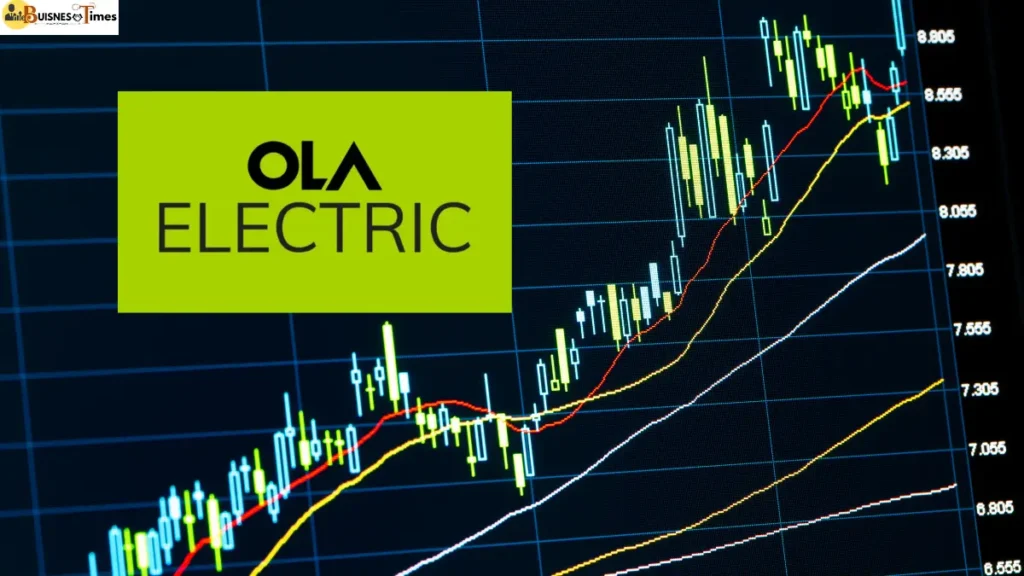Shares of Ola Electric Mobility Ltd soared as much as 11% to ₹49 per share on Wednesday after around 0.3% of the company’s equity changed hands in a series of large block deals. This surge comes at a time when the company is aggressively outlining its future roadmap in the EV sector, triggering renewed investor confidence.

The trading action was marked by ten block deals on the exchanges, sparking excitement among market participants. With this latest jump, Ola Electric has now gained in four out of the last five trading sessions, outperforming the broader market by a significant margin.
Also Read: Patel Retail IPO Opens Strong
Over the past week alone, the stock has rallied nearly 20%, compared to just a 1% rise in the benchmark Nifty 50 index. This clear outperformance underscores investor belief in Ola Electric’s strategic direction and long-term potential in India’s fast-growing electric vehicle (EV) industry.
Block Deal Activity: What It Means for Ola
Block deals, which are typically large trades executed by institutional investors, often signal renewed confidence or strategic stake shifts. The 0.3% equity turnover in Ola Electric through these block deals indicates that big players are taking positions in the company, likely anticipating stronger growth in the coming quarters.
For retail investors, such block deals often serve as a sentiment booster, suggesting that smart money is betting on the stock. This partly explains the sharp surge in Ola Electric’s share price in Wednesday’s trading session.
Sankalp Event: Ola’s Bold Growth Strategy
Earlier this week, the company drew headlines when founder and chairman Bhavish Aggarwal outlined Ola Electric’s ambitious vision during the company’s annual Sankalp event.
Aggarwal set a bold target of capturing 25–30% of India’s two-wheeler EV market — a goal that, if achieved, could firmly establish Ola as the dominant EV player in the countryKey Highlights from Aggarwal’s Vision:
- Target Market Share: 25–30% of India’s electric two-wheeler market.
- Profitability Goal: High-margin growth driven by vertical integration.
- Product Strategy: Expansion beyond scooters into electric bikes and other new launches.
- Long-Term Outlook: Position Ola not just as an EV manufacturer but as a tech-driven mobility giant.
“Our target market share for two-wheeler EVs is about 25 to 30 percent with very high margins, so we believe we are on the trajectory again,” Aggarwal said, emphasizing that Ola’s “mojo is still there” despite recent challenges.
Transition Phase: From Gen 2 to Gen 3 & Beyond
Over the last six months, Ola Electric has undergone a critical transition phase in its product portfolio. The company phased out its older Gen 2 scooters and ramped up supplies of its Gen 3 models, which are designed to be more reliable, efficient, and cost-effective.

At the same time, Ola rolled out its first electric bike, a move that expands its product range and appeals to a wider audience.
“It’s been two quarters of transition. Along with product transition, we’ve had a distribution scale-up. You’ll now see, leading into the festive season, the market share volumes starting to inch upwards,” Aggarwal told shareholders.
This transition is crucial as the company prepares to capitalize on festive demand, a period that traditionally drives vehicle sales in India.
Profitability Challenge: Why Vertical Integration Matters
While EV adoption in India is accelerating, profitability has been a major hurdle for most players. Aggarwal stressed that scale alone is not enough — companies must invest in technology development, vertical integration, and innovation.
“No one is making money. To make money with EVs, you need vertical integration, you need the technology development, you need the DNA of technology,” Aggarwal explained.
Ola’s strategy of controlling the entire EV value chain — from battery development to manufacturing — is expected to help it reduce costs and improve margins.
Financial Performance: Narrowing Losses, Improving Margins
Ola Electric’s first-quarter earnings for FY26 reflected a mixed picture. While the company reported weaker results compared to the same quarter last year, the numbers showed sequential improvement, with losses narrowing and revenues rising.
- Gross Margin: Improved by 1,100 basis points quarter-on-quarter.
- Year-on-Year Margin Growth: Up 740 basis points compared to last year.
- Current Gross Margin: Stands at 26% as of June 2025.
- Future Guidance: Management expects full-year margins of 35–40%.
This margin expansion reflects Ola’s focus on efficiency, better product mix, and vertical integration. Investors view this as a positive trajectory, even if absolute profitability is still some distance away.
Ola in the Broader EV Landscape
India’s EV market is at a tipping point, with government policies, rising fuel costs, and consumer awareness driving adoption. Two-wheelers dominate India’s automobile sector, and Ola’s aggressive focus here could give it a strategic edge over rivals.
Currently, Ola competes with players like Ather Energy, Bajaj, and TVS, but its scale, branding, and technology investments give it the potential to emerge as the EV leader.
Moreover, Ola’s push toward sustainable mobility solutions aligns with India’s larger ambition of achieving 30% EV penetration by 2030.
Ola Electric Share Price Performance at a Glance
| Metric | Performance |
|---|---|
| Current Share Price | ₹49 (as of Aug 20, 2025) |
| Intraday Gain | 11% |
| Weekly Gain | ~20% |
| Benchmark Nifty 50 | +1% (same period) |
| Block Deal | 0.3% equity turnover across 10 deals |
| Market Sentiment | Strongly bullish |
Investor Sentiment: What Analysts Are Saying
Market analysts believe that Ola Electric’s growth story remains strong, despite near-term challenges. The combination of rising EV adoption, improved product mix, and margin expansion is expected to support the stock in the medium term.
Some experts caution that the company still needs to prove sustainable profitability, but with its ambitious roadmap, Ola Electric is positioned to benefit from long-term structural tailwinds.
Outlook: What to Expect Next
As Ola prepares to ramp up production and launches ahead of the festive season, investors will be closely watching:
- Demand for Gen 3 scooters and electric bike.
- Margin trajectory in upcoming quarters.
- Market share growth towards the 25–30% target.
- Execution of vertical integration strategy.
If Ola successfully delivers on these fronts, the company could cement itself as the flagbearer of India’s EV revolution.
The 11% surge in Ola Electric shares on August 20 isn’t just about a block deal — it’s a reflection of renewed investor confidence in the company’s long-term strategy.
With Bhavish Aggarwal’s ambitious roadmap, Ola Electric is aiming to not only lead the EV race in India but also reshape the country’s mobility landscape.
For investors, the road ahead may still have bumps, but the direction seems firmly set towards growth, scale, and profitability.
Disclaimer: This article on BusinesTimes.com is for informational purposes only and should not be considered investment advice. Stock market investments are subject to risks. Readers are advised to consult a certified financial advisor before making any investment decisions.

